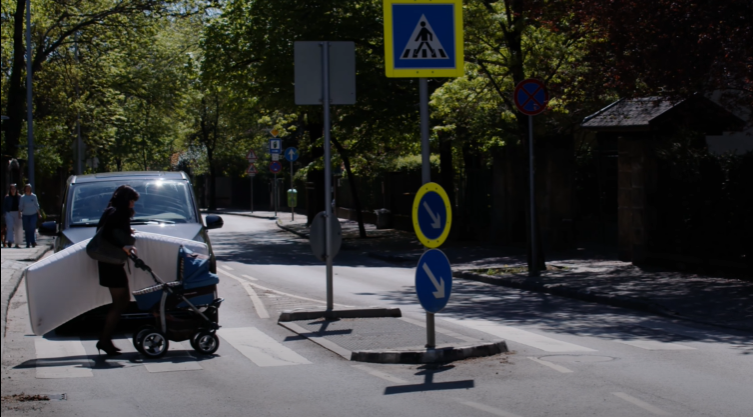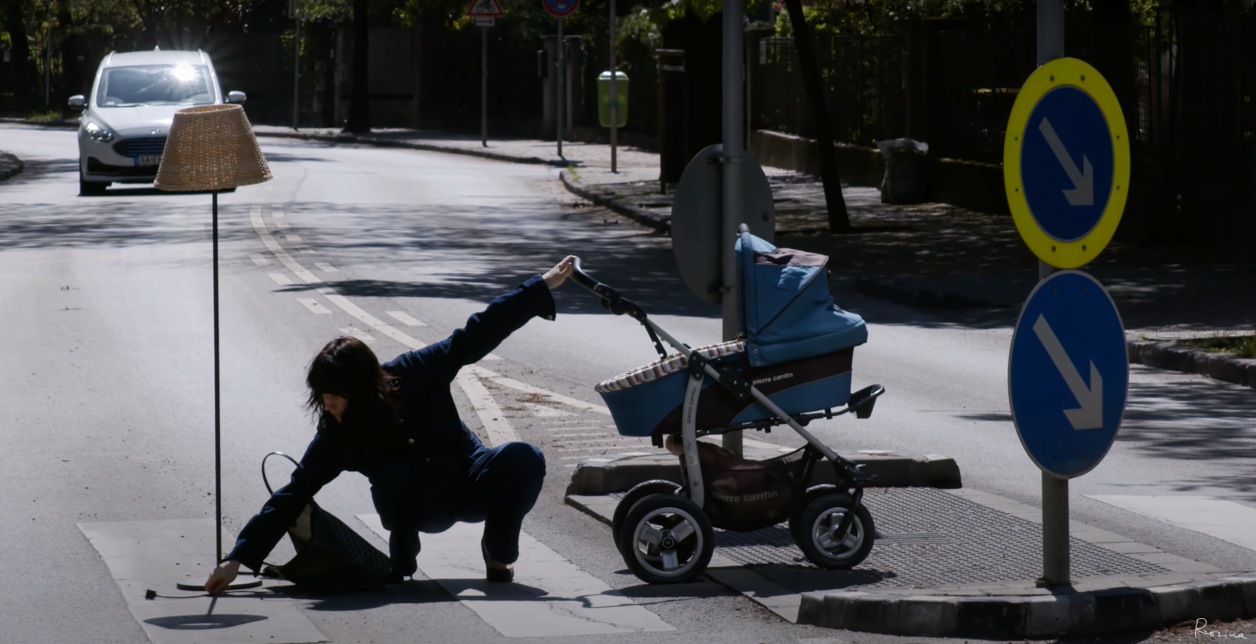The Unbearable Weight of Being: Rozina Pátkai’s Invisible / Láthatatlan
In Invisible / Láthatatlan, Rozina Pátkai stages a quietly powerful work of feminist performance art, exposing the invisible mental and physical burdens of domestic labour by physically enacting its weight in public space.

I. Invisible / Láthatatlan. Performance, Performativity, and the Mental Load
In Invisible / Láthatatlan (2025), Vienna-based artist Rozina Pátkai stages a harrowing yet subdued choreography of domestic burden. Repeatedly crossing a zebra-striped pedestrian crossing in what appears to be a Hungarian suburb, she struggles beneath the accumulated flotsam of household care: a drying rack, shopping trolley, mattress, pushchair, a child’s balance bike, and so on. She drops them, stumbles, regathers. Traffic slows. Nobody helps (except one woman around the halfway mark). The video, in under five minutes, captures a performance that is as banal as it is monumental.
This is not theatre. It is not film. It is a performance that draws from what performance theorist Peggy Phelan called the “presentness” of performance – its being “in a real time of bodies in space” (Phelan, 1993). Pátkai places herself not on a stage but in public view, amid the flow of everyday life. The camera, static and discrete, records but does not announce. The audience, unsuspecting, participates unwittingly. This covert element – a hallmark of much site-specific and feminist performance – recalls the uneasy slippage between life and art that early performance sought to establish.
As I noted in a previous discussion on Marina Abramović and the musealisation of performance, performance art’s energy often resists the institutional impulse to preserve, document, and tame. Invisible / Láthatatlan similarly resists. Its ephemerality is key: there is no ticket, no press release, no gallery guide. Just a woman carrying too much, and a society willing to watch.
Yet it is also deeply structured. Pátkai invokes the visual language of feminist performance of the 1970s: think of Mierle Laderman Ukeles’s Maintenance Art Manifesto (1969), where the artist declared domestic labour to be an artistic act; or Martha Rosler’s Semiotics of the Kitchen (1975), in which the vocabulary of kitchen tools becomes a language of constraint. These works, like Pátkai’s, insist that “women’s work” – unpaid, undervalued, and often invisible – be recognised not only as labour but as a critical lens through which to view the politics of care and gender inequality.
II. Feminist Performance and the Unseen Audience
The anonymity of Pátkai’s audience (the drivers and pedestrians who engage in the performance unknowingly) places the viewer in a double bind. We are both outside and inside the scene. Watching the filmed performance, we may feel ourselves aligned with the artist, recognising the injustice of her burden. Yet we are also implicated: how many times have we walked past someone clearly overburdened, emotionally or physically, and done nothing?
This kind of ethical mirroring has a long history in feminist performance. In Rhythm 0 (1974), Marina Abramović famously offered her body to the public, along with 72 objects including a loaded gun. Over six hours, the audience’s inhibitions collapsed, revealing their capacity for cruelty and violation. While Pátkai’s performance is less overtly violent, it is perhaps more insidious. It renders visible not what people will do under artistic license, but what they will not do in everyday life. Her encumbrance becomes a test of others’ thresholds. How much discomfort can they bear to witness before action becomes imperative?
This resonates with what philosopher Sara Ahmed has called “the feminist killjoy” (Ahmed, 2010). The one who calls attention to the inequalities others would rather ignore. Pátkai’s work is a feminist killjoy performance par excellence: a reminder that the comfort of others often depends on the unnoticed sacrifices of women. Her burden is psychological as well as physical, a theatrical representation of what sociologist Arlie Hochschild termed “the second shift”: the unpaid domestic work women undertake after formal employment ends (Hochschild & Machung, 1989).
III. The Long Arc of Recognition
The pacing of the performance (slow, repetitive) mirrors the tempo of social change itself. Women’s liberation movements of the 20th century achieved enormous strides in public and professional life, yet the private sphere remains stubbornly resistant to transformation. The mental load – the planning, remembering, organising, and emotional labour – remains unevenly distributed in heterosexual households, as numerous contemporary studies confirm (Daminger, 2019; Carlson et al., 2016).
Pátkai’s piece therefore bridges the personal and the political, the historical and the contemporary. While artists like Adrian Piper, Valie Export, and Suzanne Lacy used the body in public space to confront gendered violence, sexualisation, and surveillance, Pátkai turns our attention to the quieter oppressions that rarely draw protest or outrage. Her body is not eroticised or attacked, but merely tolerated, as long as it does not demand too much of others.
The scene in Invisible / Láthatatlan in which a woman finally steps forward to help, is poignant. It is an act of solidarity that punctures the otherwise uniform indifference of the passersby. Yet even this gesture is bittersweet, for it affirms the notion that women must care for each other because no one else will. In that sense, Pátkai’s work does not offer closure or catharsis. It is not hopeful. It is honest.
References
- Abramović, M. (1974). Rhythm 0. Performance.
- Ahmed, S. (2010). The Promise of Happiness. Duke University Press.
- Carlson, D. L., Miller, A. J., & Sassler, S. (2018). “Stalled for Whom? Change in the Division of Particular Housework Tasks and Their Consequences for Middle- to Low-Income Couples”. Socius.
- Daminger, A. (2019). “The Cognitive Dimension of Household Labor”. American Sociological Review.
- Hochschild, A., & Machung, A. (1989). The Second Shift. Viking.
- Phelan, P. (1993). Unmarked: The Politics of Performance. Routledge.
- Rosler, M. (1975). Semiotics of the Kitchen. Video Art.
- Ukeles, M. L. (1969). Maintenance Art Manifesto.
Watch the performance here:
Invisible / Láthatatlan – Rozina Pátkai (YouTube)

